Liquid Biofuel Production in Eastern Africa: The Sustainability Challenge of Land and Feedstock Availability
Miftah F. Kedir *1, and Mutta Doris 2
1Ethiopian Forestry Development, Central Ethiopia Center, P.O.Box 33042, Addis Ababa, Ethiopia,
2African Forest Forum (AFF), United Nations Avenue, P. O. Box 30677-00100, Nairobi, Kenya (doris_mutta@yahoo.com),
*Corresponding author: E-mail: mfkedir@gmail.com, Tel. +251911574736
ABSTRACT
Liquid biofuel utilization is required to keep global warming below 2°C. In eastern African countries like Ethiopia, Sudan, Kenya, Tanzania, and Uganda, feedstocks for liquid biofuel production do not conflict with food crops. This study aimed to determine the land and feedstock availability for biofuel production in selected eastern African countries. In Ethiopia, 23.3 million ha of land area is suitable for biodiesel crops and 333,500 ha for bioethanol crops. Sudan has more than 60 million ha of land suitable for biofuel crops. In Tanzania, 435,000 ha of land was allocated for biofuel crops. In Uganda, 60% of the arable land area is ideal for Jatropha and 50% for sugarcane. About 20% of the potential arable land in Kenya is suitable for Croton. In 2009 Kenana Sudan Sugar Company launched 65 million litres of ethanol production. Tanzania was producing biodiesel for electricity. Uganda produced ethanol from sweet sorghum. Ethiopia and Tanzania can produce 35.588 and 7.089 billion liters of lignocellulosic ethanol, respectively, higher than their import of petroleum. However, other Eastern African countries, such as Burundi and Djibouti, had no liquid biofuel production in 2023. In eastern Africa, land and feedstock are widely available to produce biofuel for clean bioenergy that should be used in appropriate land use plan.
Keywords: biodiesel, bioethanol, feedstock, land, land use, productivity
INTRODUCTION
Liquid biofuels are produced from biomass, which can also make solid and gaseous biofuels for energy use in transport, heat, or electricity. Approximately 15% of total global energy and 80% of current bioenergy use (ca 35 EJ yr_1) is obtained from traditional biomass1,2.
Globally, over 2.7 billion people will have no access to clean cooking energy by 20302, and 840 million currently lack access to electricity, showing significant disparities with the promise of energy for all.3 However, Energy contributes 75 percent of global greenhouse gas emissions, mainly from burning fossil fuels. Then, a just and inclusive transition from traditional and fossil fuels, like fuelwood or liquefied petroleum gas (LPG), to clean cooking options, including bioenergy, is needed as a contribution to achieving affordable, reliable, sustainable, and modern energy in sustainable development goals (SDGs) of number seven.
Projections showed that the world will experience net deficits in petroleum supplies as new oil discoveries are offset by depletions before 20304. These disparities will mainly occur in Sub-Saharan Africa. On the other hand, global warming levels greater than 2°C will damage global biodiversity, natural ecosystems, water supply, food production, and health. 2013, the world warmed by nearly 1°C compared to the preindustrial revolution stage.5 The 2010 Cancun Climate Change Conference of Parties and Paris Agreement 2015 stated that the rise in world temperatures to "well below 2°C and limit to 1.5°C" cannot be attained without biofuel 6,7.
Liquid biofuels are needed to transport fuel, fuel enhancers, and fossil fuel substitutes and satisfy government use mandates or environmental regulations. The fuel enhancer property of liquid biofuels is higher octane content in ethanol than gasoline and more excellent lubricity in biodiesel than diesel during blending. Large-scale initiation for the production and use of liquid biofuels occurred in Brazil and the United States in response to the 1973 oil export embargo imposed by the Arab members that increased oil prices. In the 1970s, liquid biofuel was in supply shortage and cost, and again, in the 2000s, it was in demand driven by environmental concerns of climate security. Policy-driven liquid biofuels were used, and as of 2016, such liquid biofuel blending mandates were established in around 70 countries in the world8. Blending of liquid biofuel was started 50 years ago in Brazil, and eastern African countries like Ethiopia have been blending ethanol into gasoline since 19799. For the future, countries like Malawi planned E20 (20% ethanol and 80% gasoline), and Brazil E100, and Indonesia B20 in 202510.
Proper technological and governance support to deploy over 200 EJ bioenergy coupled with CO2 capture and storage could help to keep global warming below 2°C of preindustrial levels.11 However, bioenergy feedstocks are land and water-intensive, which could affect ecosystems, biodiversity, and livelihoods. On the other hand, it is believed that integrating bioenergy systems into agriculture and forest landscapes can improve land and water use efficiency to reduce environmental impacts.
Biofuels have a carbon-neutral effect on climate security by reducing the emissions from fossil fuel use. The type of land cover used and feedstock produced determines the emission from liquid biofuel. Studies showed that the foreseeable deployment of biofuels varies at the global and national levels depending on technological developments, land availability, financial viability, and mitigation policies11. Sub-Saharan Africa possesses considerable resources to produce sustainable liquid biofuels. The biomass feedstocks are neither in conflict with food supplies nor increase carbon dioxide emissions because there are ample land areas that avoid deforestation. Since land availability is not a limiting factor for the production of bioenergy, about 30% of the world's fuel supply could be bio-based in 20503. Liquid biofuel feedstocks are commonly sugar cane, sugar beet, corn, oil palm, coconut oil, rapeseed, and soya beans. Ethanol was mainly produced in the US and Brazil, accounting for around 60% and 25% of the global total in 2012, where corn and sugar cane were the primary feedstocks. It is widely recognized that most food insecurity is caused by poverty and associated public policy failures rather than actual food shortages. Poor productivity and not a shortage of land usually caused food shortages. Several studies have indicated the existence of enough arable land for food and bio-energy feedstock cultivation for national and export markets in the African Region. Some African countries have a biofuel strategic plan and allocate 10-20.6% of their land to energy crops. However, it is essential to understand the biofuel strategy's status based on the sustainability guidance to individual countries in developing policies and regulations12. This review aimed to determine land and feedstock availability trends for liquid biofuel production, emphasizing eastern Africa.
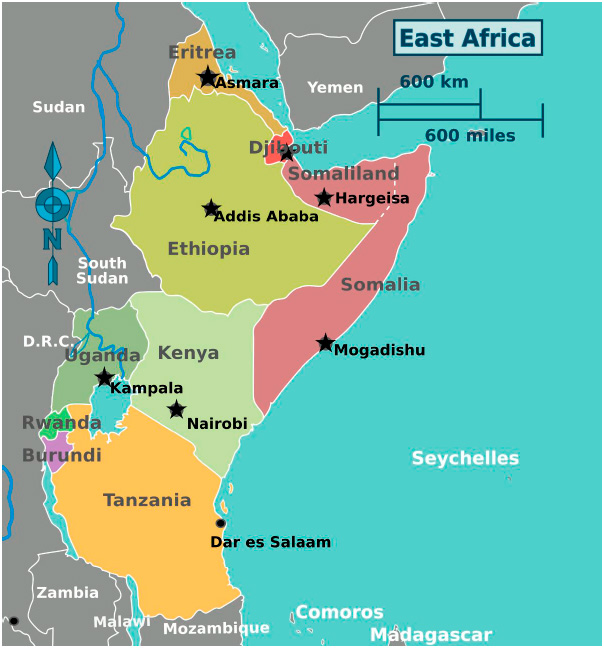
Figure 1. Map of East Africa, highlighting the countries of Djibouti, Eritrea, Ethiopia, Kenya, Somalia, South Sudan, Sudan, Tanzania, and Uganda. Major cities are also indicated. Based on a map by Peter Fitzgerald, amendments by Burmesedays, CC BY-SA 3.0 https://creativecommons.org/licenses/by-sa/3.0, via Wikimedia Commons
Land availability for the production of liquid biofuel
The land occupancy of eastern African people in 2015 had an average density of 82.08 persons per km2 13. The availability of land for liquid biofuel development in East African countries is well publicized, and the governments were calling for investors. However, forest and woodland cover of eastern Africa was about 13 % of the total area14, with an annual forest cover change rate of 0.51. The countries in the east of Africa identified that the land is suitable for biofuel crop production. In Ethiopia, 23.3 m ha of land was estimated to be appropriate for biodiesel crops15 and 333,500 ha for bioethanol crops (sugarcane) production16. In 2010, there were about 82 registered biofuel investors in the country since 2006, mainly for cultivating energy crops for biodiesel production16.
Sudan has over 60 million hectares of land cultivated through underground water irrigation17. In Uganda, about 60% of the arable land area for crop production was suitable for Jatropha production, 50% for sugarcane, and 30% for Oil palm18.
In Tanzania, about 435,000 ha of land had been acquired for biofuel production, mainly by foreign investors for sugar cane, oil palm, Jatropha, white sorghum, and sunflower19. The request was about 30,000 to 2 million area by 37 companies.20 In Uganda, Nexus Biodiesel Ltd., a private company had planted over 400 ha of Jatropha in Isimba and Masindi areas in collaboration with over 2,000 registered out-growers in around 201021.
In general view, to satisfy the growing demand for liquid biofuel, developing countries have more land area than developed (Table 1). Sub-Saharan Africa has 1.074 Gha land for crop cultivation. The land area cultivated in the world out of the potential cropping area is 28%, in Sub-Saharan Africa 17%, and in developed countries 34.9%. Especially in Sub-Saharan Africa, although the suitable land area is 27.7% of the total land area, the cultivated land area is lower than the other countries (Table 1, Figure 2,3 and 4), which indicates the future possibility of cultivating food and bioenergy crops. Africa generally has over one billion unutilized land, which can be used for liquid biofuel crop production22, 23.

Table 1. Land with rain-fed crop production potential by region (million ha) 24
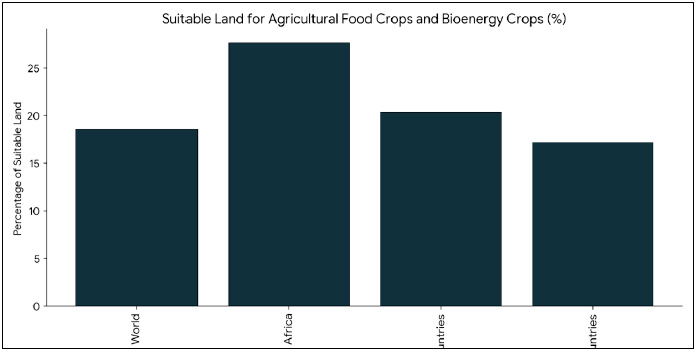
Figure 2. Land availability for biofuel production in different regions24

Figure 3. A comparison of land suitable for agricultural food crops and bioenergy crops24
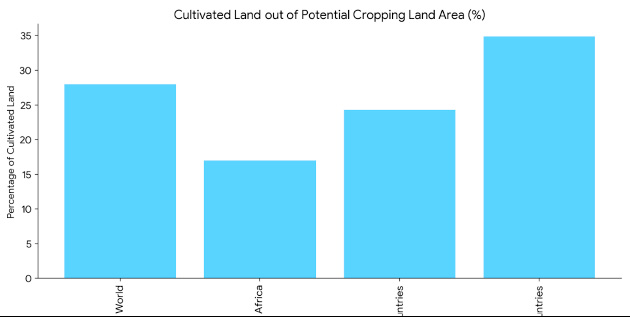
Figure 4. Area of land (percentage) suitable for agricultural food crops and bioenergy crops24
As shown in Figure 2-4, Sub-Saharan Africa has the highest rate of suitable land, followed by developing countries, the world average, and developed countries.
The availability of land requires proper policies and improvement of soil fertility. Eastern African countries like Ethiopia and Sudan had no National Land Policy (NLP) (Table 2) that impeded land use planning. Most people in East Africa live in rural areas with subsistence income. Therefore, extensive farming practice requires technological improvement. The lack of clear land tenure was another long-term investment problem (Table 2). The low proportion of the potential arable land requires additional water and nutrient input based on the topographic landscape.
Trends of feedstock availability for liquid biofuel production in eastern Africa
Several biofuel feedstocks, including Jatropha, castor, palm oil, soya bean, sunflower, sugar cane, cassava, sweet sorghum, maize, potatoes, macadamia etc., have been growing under a wide range of altitude, temperature, and rainfall conditions. Moreover, the UN document31 on biofuel revealed the need to assess additional biofuel feedstock sources, technology availability, and capacity and skill set based at the local and community level, which are well adapted to agroecology and society. This explains that local resources may fit well with the local conditions because of the suitability of the environmental requirements. For example, sugar cane has 4000 to 8000 liters of bioethanol per hectare, low vulnerability, and minimal impact of climate change (Table 3). In the case of adverse environmental effects, irrigation application and soil fertility maintenance using residues, compost, and biochar are essential.
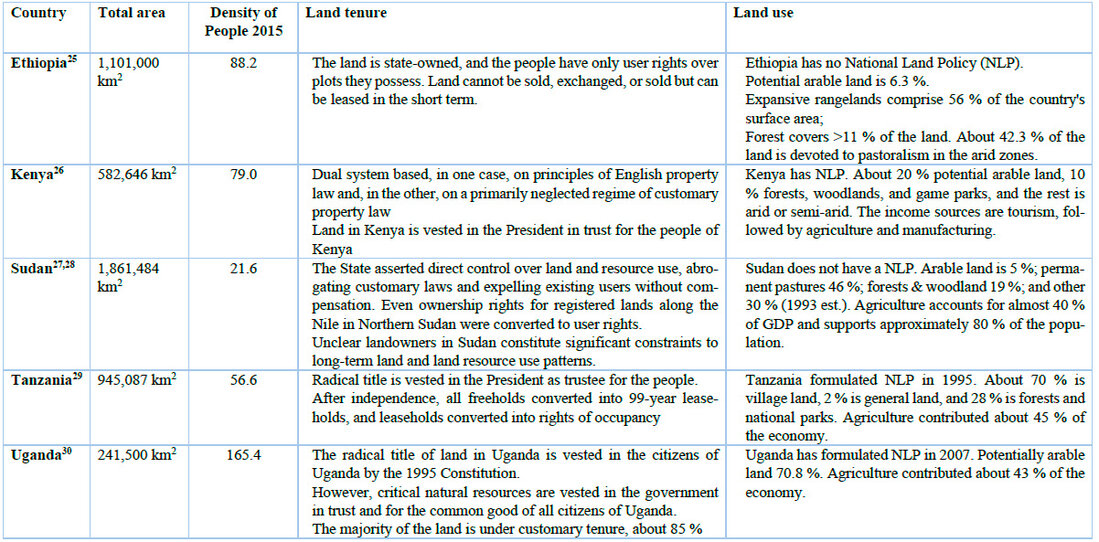
Table 2. Land area, land tenure, and land use in selected eastern African countries
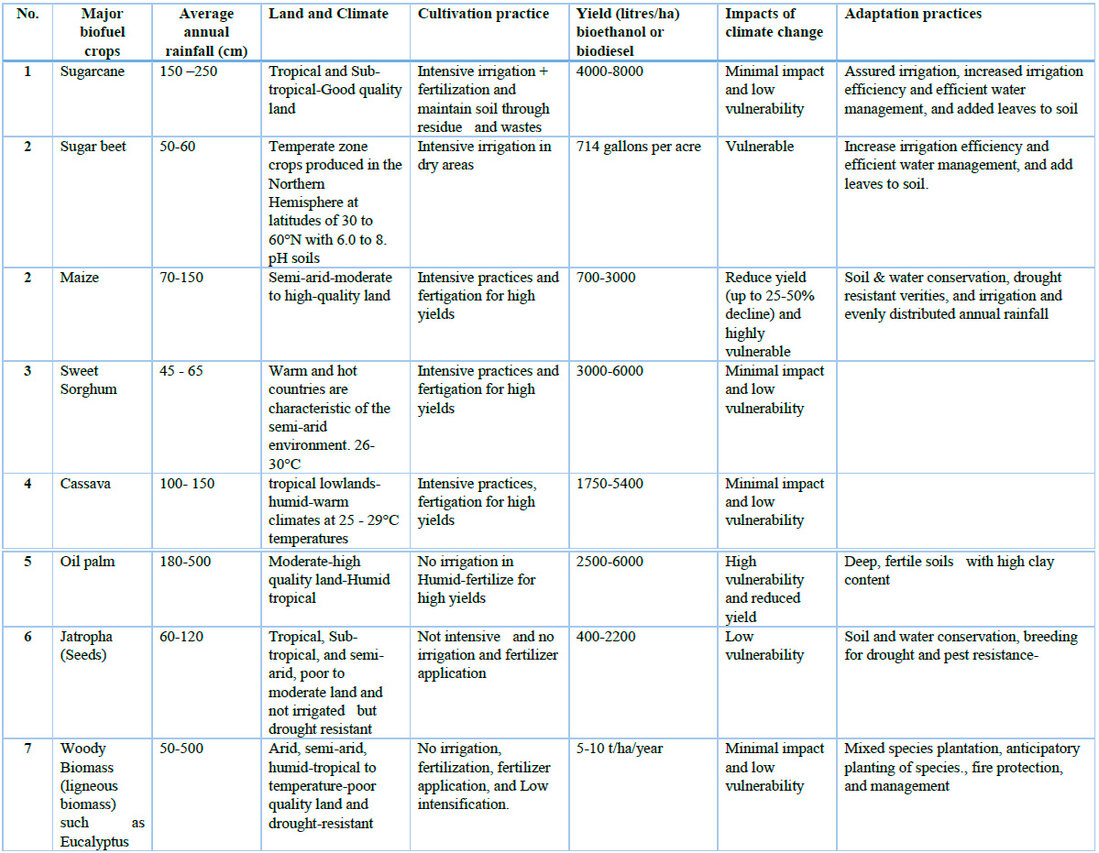
Table 3. The environmental requirement of primary liquid biofuel feedstocks in Eastern Africa32
The productivity per unit area depends upon crop variety, soil quality, rainfall and dry season irrigation, nutrient supplements, and cultural practices. For example, traditionally grown sorghum in Kenya does not contain a sweet stalk because it is primarily grown for food. However, cultivating high-yielding sweet sorghum varieties could produce grain for food and sugar for ethanol without competing with existing agricultural production24. Forexample, suitable zone of sugar cane, oil palm, sorghum, cassava and maize in Africa are in different studiess33.
In selecting potential feedstocks for biofuel production, it is essential to consider if the current domestic production levels of food and animal feed are in balance with the domestic demand. Moreover, the availability of purchasing power for some food from increased biofuel production may also be another option. If domestically produced crops can fetch more value as a biofuel feedstock than a food crop, the local food market can meet demand at affordable prices. For example, sugar cane and sugar returns as feedstock for liquid biofuels are greater than cassava and sweet sorghum. That is, sugar cane, sweet sorghum, and cassava could cost more than $2,000, $800, and more than $200 per hectare annually. The returns are many times higher than those of growing maize and beans. Studies also showed that the food value of cassava, sweet sorghum, maize, and beans is better than that of biofuel demand34. Conversely, sweet sorghum requires one-third less water than sugar cane to produce a unit of above-ground biomass (and a liter of ethanol), making it well-suited to drought-prone sugar-producing regions35. The price returns to oil crops like Croton megalocarpus and Jatropha curcas for biodiesel are $150 and less than $150 per hectare per year. However, these tree crops are helpful for shade and hedging within existing farm systems; the oils can be used locally, either as straight vegetable oil or processed to biodiesel to power diesel engines and motors in remote areas where there are imported fuels34.
Ethiopia has been producing bioethanol in small amounts since the 1950s from sugarcane molasses. Ethiopia attempted to produce ethanol from sugar cane to blend with gasoline in 1979; however, the lack of commercial feedstock and bioethanol production delayed nearly 30 years9. Since 2005, the Fincha sugar factory has produced 6 million liters of anhydrous ethanol annually as a result of a sales contract agreement entered with a foreign Italian company with an ex-factory price of $0.202 per liter until the government's decision banned the export and to use for local gasoline blending36. Metehara and Fincha sugar factories have been producing 8-million-liter bioethanol (in 2007), with plans of 83.5 million liters (in 2011) and 137 million liters (in 2015). Nile Petroleum agreed with the Ethiopian Ministry of Mines and Energy37 as the sole blending agent for three years. Later, Nile Petroleum, Oil Libya, and National Oil Company Plc (NOC) were engaged in the blending business. Ethiopia started to provide a 5 % ethanol benzene blend (E5) for the market in 2009. Ministry of Mines and Energy planned to increase the amount of bio-ethanol in the blend to E10 by 2012, E15 by 2013, E20 by 2014, and E25 by 2015. It was also revised to produce B5 and E15 in 203038. In Ethiopia, there were eight existing sugar factories and five new factories under construction, totaling 13 factories that will function at full capacity by 2023. All are supposed to produce both sugar and ethanol.
The agro-climatic conditions of Ethiopia are suitable for sugarcane production, high productivity per hectare (around 150 tons/ha), and high sucrose content (10-14 %). It takes around 1 ton of molasses to produce 250 liters of ethanol. The Sugar Corporation, together with Ethiopian Minerals, Petroleum, and Bio Fuel Development Corporation, declared to produce 50,000 liters of ethanol per day at Omo Kuraz III Sugar Industry39.
The primary feedstocks in Kenya are rape, soya bean, sunflower, peanut, cotton, avocado, Melia volkensii, Croton megalocarpus, Jatropha curcas, castor and coconut palm. Croton and Jatropha seem to be the cheapest feedstocks in Kenya compared to coconut and castor. However, farmers have little experience growing Croton and Jatropha as plantation crops, and the cost of production and revenues are less known40. Moreover, greater attention was paid to ethanol production from sugar cane molasses due to the growing poor productivity of Jatropha curcas. Moreover, the bagasse of sugar cane was also used mainly for electricity cogeneration instead of bioethanol production41.
In Sudan, LPG (i.e., propane, butane, or a mix of the two) is already the most utilized alternative to solid biomass for cooking. LPG is among the few cooking fuels, such as ethanol, methanol, biogas, biodiesel, and electricity, that can meet the indoor pollution standards set by the World Health Organization42. Sudan has a large sugar and ethanol-producing Sugar Company. Ethanol was made from sugarcane molasses, and there were five sugar factories. 2009 Kenana Sugar Company (KSC) launched 65 million liters annually of molasses fermentation ethanol production. About 90% of this ethanol was exported to the EU, and some of it was put in refueling stations in Sudan to sell as an E10 blend. The 2020 plan was to produce 200 million liters of ethanol. Sweet sorghum was also in consideration for ethanol production43. Kanana Sugar Company (KSC) made Sudan the biggest anhydrous ethanol exporter in Africa, next to South Africa. The company is planning to increase ethanol production by about 5-fold44. Sudanese experience in the previous extraction of crude oil is a potential to upgrade pyrolysis bio-oil to biodiesel and jet fuel from the thermochemical processes of lignocellulosic biomass. Jatropha has been cultivated on a small-scale farm for biodiesel production, and other biodiesel crops have been searched. In Sudan, in 2001-2002, the four Sudanese government sugar companies (SSC) produced almost 284 thousand metric tons of bioethanol compared to KSC's 405 thousand metric tons44; however, in the 2002-2003 season, the SSC plants increased their production to almost 300 thousand metric tons (ca. 6% increase).
In Tanzania, biomass energy production has become unsustainable, and the demand is accelerating year after year because of the low priority given by almost all key government agencies for the daily needed biomass energy, with perceptions that biomass energy is an inferior energy source45. However, there are success stories of producing biodiesel for mini-grid electric generation. The primary feedstocks for liquid biofuel production are sugarcane, cassava, maize, sorghum, millet, sisal, and rice for bioethanol and Jatropha, oil palm, cashew nut, coconut, sunflower, castor bean, soybean, groundnut, cotton, sunflower and Croton megalocarpus for biodiesel. FELISA Co. Ltd. (Farming for Energy) produces palm oil in an integrated system for better Livelihoods in Southern Africa. UNIDO launched biomass pilot projects in Tanzania's Kigoma and Dodoma regions to generate electricity from liquid biofuels from palm oil seeds to serve the project village46.
Uganda began commercial production of ethanol using sweet sorghum in 200747. Liquid biofuels could be more than the demand of the transport sector of Uganda by 2050 if the appropriate policies are formulated. The government also believes biofuels can benefit Uganda by providing access to clean energy services and foreign investment. Sweet sorghum and sugar cane are competitive and can be processed in the mill. There are sweet sorghum varieties as productive as sugarcane, with yields of 2–4 tons of grain, 5–7 tons of dry leaves, 15–20 tons of bagasse, and 5–9 tons of syrup, or 3,000–4,000 liters of ethanol per year48. In Uganda, the agroecological condition favors the growth of Jatropha, sugarcane, and oil palm biofuel feedstocks. Sugarcane as a biofuel feedstock was supposed to have a positive energy balance and was likely to increase sugarcane prices that benefit small-scale farmers. Maize is also a promising feedstock because food and ethanol production benefits farmers18.
Uganda was researching monitoring the agronomic performance of Jatropha curcas experiments in 2009 by the National Forestry Authority (NFA) and on the ways of producing bio-ethanol from non-food lignocellulosic feedstock such as elephant grass, cassava, and wood by National Crop Resources Research Institute. Oil palm (Dura variety of palm oil) was introduced to Uganda in 1910 and naturalized in Bundibugyo district at 750-1000 m above sea level. In 1990, fresh fruit bunch yields of 14 to 17 metric tons/ha/year at 11 years were obtained in Kituza without any soil amendments. In the Bundibugyo district, about 5,000 households cultivated 10 to 50 palms yearly and extracted 500,000 liters of palm oil annually18.
NEMAU18 also recommends using Jatropha for medicinal, pesticide, and other non-fuel uses with oil and biodiesel. The surplus production of maize and sugar cane food crops could make liquid biofuel a lucrative business in Uganda. The successful implementation of the biofuel industry at different levels requires the initiation of smallholders to produce feedstock and government subsidies for the industry. Then, Biomass biofuel feedstock identified in Uganda showed that proper use of the feedstock could meet the needs of the transport sector by 205049.
In eastern Africa, studies showed that if farmers could increase their crop productivity, they would have more food and utilize crops and residues for biofuel production, increasing their income. Although the first-generation liquid biofuels are produced only from food crops, technologies are currently emerging to produce liquid biofuels from crop residues or any form of biomass. Therefore, the solid biomass production potential indicates the more significant potential of liquid biofuel like lignocellulosic ethanol. Eastern Africa's rural livelihoods and food security are highly vulnerable to climate variability, which includes a lack of sufficient moisture and shifts in crop-growing season conditions because agriculture is heavily dependent on rain50. Liquid biofuel technology and innovation can be used to pump water from boreholes for small-scale irrigation.
In eastern Africa, biomass is a massive target of energy generation, like Ethiopia, 100MW; Kenya, 44MW; Sudan, 54MW; Tanzania, 100MW; and Uganda, 90MW. In the 2020s, much of the wood demand in eastern Africa was used for traditional wood stoves. However, as time proceeds, biomass-saving modern stoves, conversion of biomass to biogas, and electrification of cooking and heating, as African economies develop, will leave more biomass available for advanced liquid biofuels. Wood processing residues are the most cost-effective in circular biofuel economy as they can be collected over a concentrated area with low cost to transport and moderate seasonal fluctuation in feedstock availability51.
Increasing production by using high-yielding varieties under irrigation is essential for an adequate supply of biofuel feedstock.40 A study and observation in Ethiopia, Kenya, Sudan, Tanzania, and Uganda revealed that enough suitable land is available outside the existing agricultural production area to produce bioethanol and biodiesel. However, Sulle and Nelson52 emphasized that Tanzania already faced tensions over rights to use and allocate land among private, local, and governmental actors. Concerns about land laws, such as land compensation payments for displaced people due to biofuel production, are insufficient to promote alternative livelihood opportunities. Allocation of villagers' forest land used for forest-based economic activities to biofuel crop production was the most likely area to create frequent negative local impacts and grievances. On the other hand, the government showed a willingness to revise biofuel guidelines and policies based on field experiences. Similarly, Ethiopia, Kenya, Sudan, and Uganda showed different degrees of conflict on land allocation for liquid biofuel production.
Biomass for advanced biofuel production
Biomass is Africa's leading source of primary energy. Biomass can be renewable or non-renewable depending on the location of natural occurrences, regeneration, and human management. In most countries, the fraction of non-renewably lost biomass from traditional bioenergy use range between 10–30%53. Saving potential biomass through better conversion technology to liquid biofuels would restore local ecosystems. Lignocellulosic biomass produces advanced biofuels. Lignocellulosic biomasses are obtained from woody residues and other agricultural wastes. Eastern African countries have rich sources of annual residues that can be converted to liquid biofuels in the sustainable circular economy without additional land from agriculture or forestry. For example, Ethiopia, with a land area of 1.1 million km2, has an annual production of 105.2 million tons of woody residues and 19.7 million tons of agricultural residues25 (Table 4) that accounted in solid biomass energy consumption from the total final energy in 2012 from 85 to 92% (Figure 5). Ethiopia has the highest total biomass supply, followed by Tanzania, Sudan, Kenya, and Uganda. Although residual biomass can be collected freely, the National Land Policy (NLP) affects the local people, which determine the land use for different agricultural practices.

Table 4. Land areas and solid biomass energy production per year of selected eastern African countries
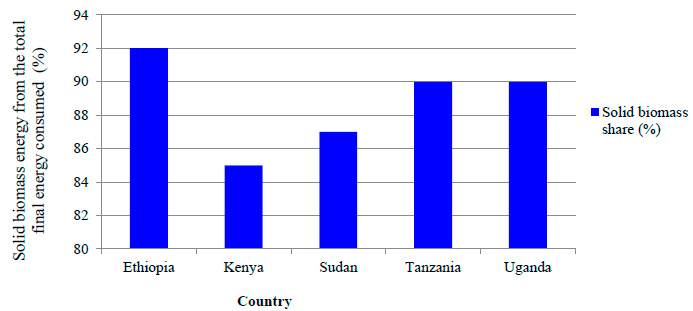
Figure 5. Percentage of solid biomass energy from the total final energy consumed in 2012
Integration of perennial and annual plant land uses for biodiesel production.
Integrating different land uses, including perennial and annual plants, was perceived to benefit the environment and abate climate change based on appropriate land use plan.. Perennial bioenergy crops harbor biodiversity, regulate flooding, and filter nutrient run-off into waterways54 as shown in Figure 6. Moreover, perennial crops have better fuel quality than annual crops. Jatropha oil is just one of many pure perennial plant oils. Vegetable oil or biodiesel can be used for different purposes, such as lighting lumps or transport engines. Although using pure plant oil instead of converting it to biodiesel reduces the costs involved in transesterification, pure plant oil has a higher viscosity than normal diesel or biodiesel, leading to unsuitable pumping and fuel spray characteristics. As a perennial plant, the Jatropha oil has a better fuel property because of its lower viscosity of 34-36 cST than other plant oils like cottonseed (36 cST) and sunflower (43 cST)55,56.
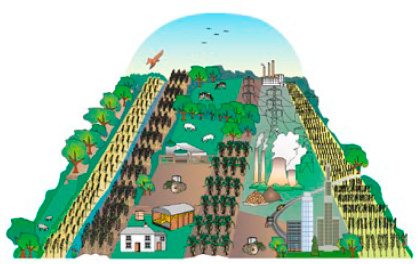
Figure 6. Integration of perennial and annual plant landuses
Greenhouse gas emissions in the production and consumption of liquid biofuel
Land-use change due to deforestation in the tropics significantly affected carbon dioxide emissions in the 1990s, which emitted 0.5 to 2.7 Giga tonnes of carbon (GtC) per year57. This emission aggravated carbon dioxide (CO2) induced climate change5,58.
The unprecedented climate change will likely increase arid and semi-arid areas in eastern Africa, reduce up to 50% yield of rain-fed agriculture, and face increased water stress by up to 250 million African people. Providing forest biomass for energy could change the management of forests, resulting in losses and gains in forest carbon stocks59. In the absence of sustainable management, forest bioenergy systems can have higher cumulative CO2 emissions than a fossil reference system at the different steps of the life cycle60. Biochemical and chemical processing of waste biomass to produce transport and cooking fuels are among the most cost-efficient and effective biomass applications for GHG emission reduction61. Liquid biofuel productions are among the most cost-efficient and effective biomass applications for GHG emission reduction. Biofuels could reduce GHG emissions by 10 to 90 % compared to fossil fuels62.
More than 650 million people in Africa are predominantly farmers and depend on rain-fed agriculture. To reduce the impact of climate change and achieve sustainability on land use and land cover change, it is essential to reduce poverty, use alternative energy sources, and create environmental education and awareness58. Liquid biofuel is needed to improve the already occurring water scarcity and land degradation, which will be further exacerbated by overgrazing, deforestation, over-cultivation etc63.
Liquid biofuels mitigate climate change by reducing carbon dioxide (CO2) emissions when compared with fossil fuels because the CO2 emission during biofuel production, processing, and combustion of biofuels is equivalent to the amount of carbon absorbed during plant growth. Then, the reduced emissions can be sold as carbon credits through the clean development mechanism (CDM) or the voluntary carbon market. However, if there is deforestation, there could be net emissions. There is also smokes created by burning the leaves and other wastes in sugar cane harvesting, which require a method for soil fertility.
The Kenyan biofuel strategy of producing biodiesel aimed at reducing the number of households using fuel wood and kerosene. The number of households using kerosene was planned to be reduced by 50% by 205064. This complies with the sustainability criteria of GBEP65, which states that modern energy services for cooking are based on energy efficiency and safety for human health. If bioethanol is supplied with a tax exemption, it could displace charcoal and kerosene, which are harmful to the health of households.
Liquid biofuel production
First-generation biofuel crops such as Jatropha, Croton, castor, sugarcane, and cassava are famous for producing liquid biofuel, which the whole world is undertaking. However, the second-generation feedstock called lignocellulosic biomass wastes is also in ample supply and can produce liquid without competition for land with crops. By considering the weight66 of 1tone of firewood as 2.1m3 and 1tone of agricultural residue 2.81m3, the ethanol production of 1tone of firewood biomass67 as 338.31 L, and 1 tone agricultural residue68 as 0.344L, the eastern African countries could produce more incredible amount liquid biofuel when compared to their annual imports. In Ethiopia, firewood biomass could produce 35.581billion liters of bioethanol, and agricultural residues produce 6.785million liters of ethanol, which is greater than the 4.5billion liters imported, that provides an extra 31.088billion liters for additional purposes or export (Table 5). All the countries shown produce extra ethanol for additional income sources from imports except Kenya, where biomass was not sufficient to substitute for imports. Sudan imports only 50% of diesel and 15% of LPG consumed in the domestic market and exports a small amount of gasoline. In 2020, there was no import of petroleum in Sudan (Table 5).

Table 5. Second-generation lignocellulosic ethanol production compared with petroleum import
Other Eastern African country biofuel production
Brundi has been sourcing most of 95% of its power from hydroelectricity, and over 97% of the people use solid firewood. From 2000 to 2023, no liquid biofuel production was done in Burundi69. In Djibouti, 67% of the total primary energy supply is dominated by biomass, which is in the trend of replacement by kerosene and other renewable energy70 such as solar, wind, and geothermal energy in 2015. Then no record of liquid biofuel was obtained in Djibouti in 2024. Different feedstock types give different liquid biofuel production chances, as shown in Table 6.
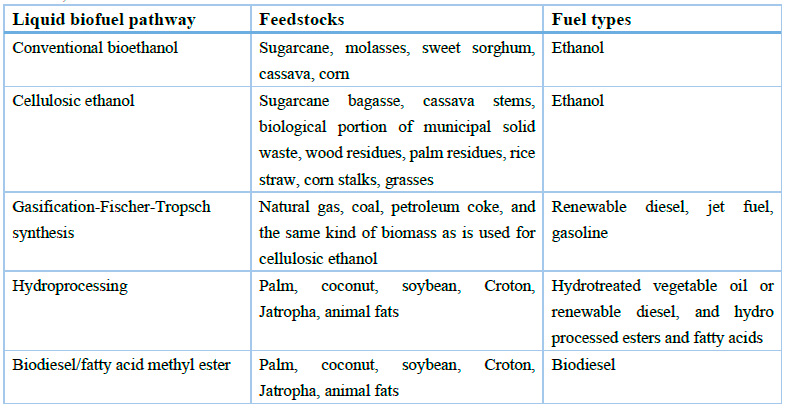
Table 6. Liquid Biofuel Production Pathways for Eastern Africa
Social and economic impacts of biofuel production on local communities
The social impacts of using biofuels in local communities are creating jobs and income at the agricultural phase of production and in the industrial processing stage. In other countries, such as Indonesia, the biodiesel mandate of B35 showed a positive impact and a significant contribution to national energy consumption 71. The success stories in food security, social development, and bioenergy development were synergistic in countries like Brazil, which can be lessons for African countries. That success was obtained from good governance, modern technologies, and business models. Integrating bioenergy with food crops and livestock attractively offered an alternative agricultural business model for specialized land use. In the same way, evidence showed that food security and economic development in Africa could be facilitated with modern bioenergy72.
However, inappropriate land use planning could result in competition between land and crops for fuel and food, resulting in an ultimate conflict of investment on biofuel and termination of biofuel, as shown in the 2010s, when all initiated biofuel investments were terminated.
Challenges and barriers to biofuel development
The eastern African countries, similar to other developing countries, were challenged with inappropriate policies and a lack of technology to use the available land and biofuel feedstock73. The road network and farm management practices of the required infrastructure in Eastern African countries are not well developed. Government policies also determine the market developments of biofuel because the government is the leading actor in fuel import. Generally, guidelines, markets, and infrastructure for biofuel production are poorly developed in Eastern African countries74. Therefore, solving the barriers requires awareness creation at local people and government levels on developing appropriate infrastructure selection of land and species for biofuel production. The bottom-up approach of development-oriented research should be devised at the institutional level.
CONCLUSION AND RECOMMENDATIONS
Liquid biofuel development is essential for advancing agriculture through increased productivity, diversifying crop variety, providing energy for mechanization, and market opportunity. Biofuel is also needed to reduce emissions created by fossil fuels based on sustainable production that doesn't compromise food and land. Efficiency and innovation on land and feedstock utilization for liquid biofuel production are crucial based on sustainable development. Biofuel production that avoids deforestation and uses circular economic concepts is the basis of sustainable development. Eastern African countries have better potential of producing liquid biofuel because of the vast unutilized land area, suitable soil, climate, and a wide variety of feedstocks. The unprecedented climate changes, which will increase the vulnerability of the eastern African people to different socioeconomic factors, require liquid biofuel because liquid biofuels can be stored and used. In addition to the availability of land for first-generation energy crops, eastern African countries have woody and agricultural residues; Ethiopia, Kenya, Sudan, Tanzania, and Uganda can produce 35.590billion liters, 5.383billion liters, 2.230billion liters, 7.090billion liters, and 2.770billion liters of lignocellulosic ethanol which is higher than their annual import of petroleum. Other Eastern African countries, such as Brundi and Djibouti, had no liquid biofuel production until 2023.
Since many first-generation biofuels are made from food and feed crops, they may be sources of land use change emissions; therefore, sustainable and environmentally friendly feedstocks should be chosen to support low-carbon growth. The potential of eastern African land and feedstock should be used to improve the livelihood of the people by using the global market demand for liquid biofuel, to reduce fossil-based emissions, create jobs for the population, and use the culture of smallholder agriculture as an out-growers scheme, feedstock sale and to create small industries. However, the rain-fed practice is deplorable, and therefore, fertilizer and irrigation coupled with improved varieties should be used by smallholder farmers and large-scale producers to increase productivity in appropriate land use plan. Moreover, capacity should be developed to produce lignocellulosic liquid biofuel from the waste biomass.
Supplementary Materials: Not available
Author Contributions: Doris designed and set the objective of the research activity; Kedir reviewed and wrote the paper; then Doris reviewed the paper depending on the purpose; Kedir amended the paper, and all authors approved the final version.
Funding: The authors would like to thank the African Forest Forum for the support of the review work.
Institutional Review Board Statement: The study was conducted according to the guidelines of the African Forest Forum, but humans and animals were omitted.
Acknowledgments: The authors would like to thank the African Forest Forum for the support of the review work.
Conflicts of Interest: The authors declare no conflict of interest.
REFERENCES
1. Chum H, Faaij A, Moreira J, Berndes G, Dhamija P, Dong H, Pingoud K. Bioenergy. In IPCC Special Report on Renewable Energy Sources and Climate Change Mitigation, (eds Edenhofer O, Pichs-Madruga R, Sokona Y, Seyboth K, Matschoss P, Kadner S, Zwickel T, Eickemeier P, Hansen G, Schleomer S, Von Stechow C). Cambridge University Press, Cambridge, United Kingdom and New York, NY, USA. 2011; 209-32.
2. OECD/ IAE. Energy Access Outlook Special Outlook 2017. From Poverty to Prosperity. 2017; 144.
3. IEA. Statistics. Retrieved from https://www.iea.org/statistics/. 2019. Accessed on 11 June 2020.
4. MoE (Ministry of Energy). Strategy for developing the Bio-Diesel Industry in Kenya (2008-2012). Renewable Energy Department. Nairobi, Kenya. 2008; 44.
5. IPCC (Intergovernmental Panel on Climate Change). Climate Change: Mitigation of Climate Change. Contribution of Working Group III to the Fifth Assessment Report of the Intergovernmental Panel on Climate Change [Edenhofer O, Pichs-Madruga R, Sokona Y, Farahani E, Kadner S, Seyboth K, Adler A, Baum I, Brunner S, Eickemeier P, Kriemann B, Savolainen J, Schlömer S, von Stechow C, Zwickel T, Minx JC (eds.)]. Cambridge University Press, Cambridge, United Kingdom and New York, NY, USA. 2014.
6. Cruz BCH, Souza GM, Cortez LB. Biofuels for transport. In: Lechter, Trevor (Ed.), Future Energy. Elsevier. 2014; 236.
7. Rogelj J, den Elzen M, Höhne N, Fransen T, Fekete H, Winkler H, Schaeffer R, Sha F, Riahi K, and Meinshausen M. Paris Agreement climate proposals need a boost to keep warming well below 2 °C. Nature.2016; 534: 631–39. http://dx.doi.org/10.1038/nature18307. 2016. Accessed on 05/10/2019.
8. IEA, IRENA, UNSD, WB, WHO. Tracking SDG 7: The Energy Progress Report 2019, Washington DC. 2019.
9. DSD (Dutch Sustainable Development Group). Feasibility study on an effective and sustainable bio-ethanol production program by least developed countries as alternative to cane sugar export. Ministry of Agriculture, Nature and Food Quality (LNV), 2ed. June 2005.
10. STAP. Optimizing the Global Environmental Benefits of Transport Biofuels. Scientific and Technical Advisory Panel of the Global Environment Facility, Washington, DC Authored and edited by Bierbaum R, Cowie A, Gorsevski V, Sims R (STAP); Rack M, Strapasson A, Woods J (Imperial College, London) and Ravindranath N (Indian Institute of Science, Delhi). 2014.
11. Creutzig F, Ravindranath NH, Berndes G, et al. Bioenergy and climate change mitigation: an assessment. GCB Bioenergy, 2014; 7(5): 916–44. https://doi.org/10.1111/gcbb.12205.
12. Agenda 2063. The Africa We Want: A Shared Strategic Framework for Inclusive Growth and Sustainable Development, First Ten- Year Implementation Plan 2014-2023. 2014.
13. UNDESA, United Nations Department of Economic and Social Affairs - Population Division Total Population Both sexes, July, 2015. Archived from the original on 2015-12-22. 2015. Retrieved 2020-09-11.
14. UNEP. United Nations Environment Programme. Africa Environment Outlook: Past, Present and Future Perspectives. Nairobi, Kenya. 2002.
15. Forum for Environment. Assessment of Biofuel Development Activities in Ethiopia, Addis Ababa: Unpublished Report. 2011.
16. Gebreegziabher Z, Mekonnen A, Ferede T and Köhlin G. Profitability of Biofuels Production: the Case of Ethiopia. Environment for Development Initiative. https://www.jstor.org/stable/resrep15006. 2014. Accessed on: 07 May2020.
17. Wida'a AA. Biofuel Potential for Transport Sector in Sudan: Extractive Industries and Sustainable Job Creation. UNCTAD 17th Africa OILGASMINE, Ministry of Petroleum and Gas, Republic of the Sudan. Khartoum. 2015 Nov.; 23-6.
18. NEMAU (National Environment Management Authority of Uganda). The Potential of Bio-fuel in Uganda: an Assessment of Land Resources for Bio-fuel Feedstock Suitability. Kampala, Uganda. 2010; 52. http://www.nemaug.org.
19. Action Aid-Tanzania. Implication of Biofuels Production on Food Security in Tanzania. Arusha. 2009.
20. Kamanga KC. The Agrofuel Industry in Tanzania: A Critical Enquiry into Challenges and Opportunities. A research report. Hakiardhi and Oxfam Livelihoods Initiative for Tanzania (JOLIT), Dar es Salaam. 2008.
21. WWF. Opportunities and barriers to the use of renewable energy technologies in Uganda. World Wide Fund for Nature. 2012.
22. Amigun B, Musango JK, Stafford W. Biofuels and sSustainabilityin Africa. Renewable Sustainable Energy Review. 2010.
23. AFF. The State of Forestry in Africa: Opportunities and Challenges. African Forest Forum, Nairobi Kenya. 2019; 186.
24. FAO. Biofuel co-products as livestock feed - Opportunities and challenges, edited by Harinder PSM. Rome, Italy. 2012.
25. MoWE (Ministry of Water and Energy). Ethiopian National Energy Policy 2nd draft. Addis Ababa, Ethiopia. 2012; 54.
26. Republic of Kenya. Study on Kenya's Energy Demand, Supply and Policy Strategy for Households, Small Scale Industries and Service Establishments. Ministry of Energy, Nairobi, Kenya. 2002.
27. Omer AM. Agricultural Residues for Future Energy Option in Sudan: An Analysis. Ann Adv Chem., 2018; 2: 17-31. https://doi.org/10.29328/journal.aac.1001011.
28. Demirel B, Gürdil GAK, Gadalla O. Biomass energy potential from agricultural production in Sudan. ETHABD. Dergi Park Acad. ISSN: 2651-5334. 2019; 2(2): 35-8.
29. MNRT. Tanzania National Forest Resources Monitoring and Assessment. NAFORMA. Brief report. Tanzania Forest Services Agency. 2013.
30. MEMD-GOU (Ministry of Energy and Mineral Development). Biomass energy strategy (BEST) Uganda. 2013; 114.
31. UN (United Nations). Report of the Conference of the Parties Serving As the Meeting of the Parties to the Kyoto Protocol on Its First Session, Held at Montreal from 28 November to 10 December 2005. Part Two: Action Taken by the Conference of the Parties; UN: New York. 2005. Available at: http://cdm.unfccc.int/methodologies/SSCmethodologies/approved.html.
32. Wetland International. Biofuels in Africa. Wetland International. 2008.
33.IIASA/FAI. Global Agroecological Assessment for Agriculture in the 21st Century. 2002. Available on http://www.iiasa.ac.at/Research/LUC/SAEZ/index.html.
34. Wiggins, S, Keane J, Kennan J, Leturque H and Stevens C. Biofuels in eastern Africa: dangers yes, but much potential as well: project debriefing. Overseas Development Institute. 2011. Available on www.odi.org.uk. Accessed on 11/05/2020.
35. Elbehri A, Segerstedt A, Liu Pl. Biofuels and the Sustainability challenge: A global assessment of sustainability issues, trends and policies for biofuels and related feedstocks. Trade and Market Div. FAO, Rome. ISBN 978-92-5-107414-5. 2013; 188.
36. Tekle G. Local production and use of bio-ethanol for transport in Ethiopia status, challenges and lessons. Thesis for the fulfillment of the Master of Science in Environmental Management and Policy IIIEE, Lund University, Sweden. ISSN 1401-9191. 2008.
37. MoME (Ministry of Mines and Energy). List of Organizations Involved in Biofuel Devel and Prod. in Ethiopia, Trans from Amharic to English by Sofia T., MME. 2009.
38. CRGE (Climate-Resilient Green Economy). Ethiopia's Climate-Resilient Green Economy, Green Economy Strategy: the path to sustainable development. Environmental Protection Authority, GoE; Addis Ababa, Ethiopia. 2011; 188.
39.Yewondwossen M. Ethiopian ethanol production closer to reality. Capital Ethiopia. 2018. Available at https://www.capitalethiopia.com/capital/ethiopian-ethanol-production-closer-realty.
40. GTZ and KMoA (Kenyan Ministry of Agriculture). A Roadmap for Biofuels in Kenya – Opportunities & Obstacles, Nairobi, Kenya. 2008.
41. Karekezi S, Kimani J. Status of Bioenergy Development in Kenya: The Case of Bagasse-based Cogeneration, Bioenergy study theme paper, Global Network on Energy for Sustainable Development (GNESD). 2010.
42. Hafner M, Tagliapietra S, de Strasser L. Energy in Africa Challenges and Opportunities. ISSN 2191-5520 ISSN 2191-5539 (electronic), Springer Briefs in Energy, 2018. ISBN 978-3-319-92218-8 ISBN 978-3-319-92219-5 (eBook). https://doi.org/10.1007/978-3-319-92219-5.
43. Abdelraheem HF, Lang A. Production of transport biofuels in Sudan for replacement of petroleum fuels: the fundamental issues. 2015; 8..
44.Hussein AM. Ethanol comes third in Sudan's exports. 2012. Available: http://sudanow.info/new/uncategorized/ethanol-comes-third-in-sudans-exports/. Accessed. on 12 Aug. 2020.
45. Camco Clean Energy. Biomass Energy Strategy (BEST) Tanzania, Tanzania Biomass Energy Strategy and Action Plan, Final Report. Pp. 138. Camco Clean Energy (Tanzania) Limited. 2014.
46. UNDESA (United Nations Department of Economic and Social Affairs). Small-Scale Production and Use of Liquid Biofuels in Sub-Saharan Africa: Perspectives for Sustainable Development. Energy and Transport Branch Division for Sustainable Development United Nations Department of Economic and Social Affairs. Background paper No.2, DESA/DSD/2007/2. 2007; 51.
47. Kojima M, Mitchell D, and Ward W. Considering Trade Policies for Liquid Biofuels. Energy Section Management Assistance Program, World Bank, Washington, DC. 2007.
48. Nimbkar N, Rajvanshi A. Sweet Sorghum Ideal for Biofuel. Seed World 14. Nov. 2003; no. 8.
49. IRENA. Biofuel potential in Sub-Saharan Africa: raising food yields, reducing food waste and utilizing residues. International Renewable Energy Agency, Abu Dhabi. 2017.
50. Case M. Climate Change Impacts on East Africa. Rev. of Scientific Literature. WWF. 2006; 1-12. Available at <http://assets.panda.org/downloads/east_ africa_climate_change_ impacts_pdf_1.pdf>. Accessed on 10 August 2020.
51. Ackom E. Bbiomass assessment for 6 MW biomass power project in Kumasi-Ghana Accra", ECOWAS/GBEP. Bioenergy Week. 23 June 2017
52. Sulle E, Nelson F. Biofuels, Land Access and Rural Livelihood in Tanzania, IIED, London. 2009. ISBN: 978-1-84369-749-7.
53. UNFCCC-CDM. CDM-SSC WG, Annex 8. UNFCCC-CDM, Bonn. 2012.
54. Souza GM, Victoria RL, Joly CA, Verdade LM(eds). Bioenergy and Sustainability: bridging the gaps. São Paulo, Brazil. 2015; 779. ISBN: 978-2-9545557-0-6.
55. Akintayo ET. Characteristics and composition of Parkia biglobbossa and Jatropha curcas oils and cakes. Bioresource Tech., 2014; 92 (3): 307-10. ISSN: 09608524.
56. Knothe G, Steidley KR. Kinematic viscosity of biodiesel fuel components and related compounds. Influence of compound structure and comparison to petro-diesel fuel components. Fuel. 2005; 84 (9): 1059-65. ISSN: 0016-2361
57. UNFCCC (United Nations Convention on Climate Change). Sustainable Bioenergy: A Framework for Decision Makers. United Nations. 2009.
58. Eze JN, Onokala PC. Analysis of land use and land cover change in the Sahel: a case study of Yobe State, Nigeria. Climate Change. 2020; 6(21): 120-28.
59. Lundmark T, Bergh J, Hofer P, Lundström A, Nordin A, Poudel BC, Werner F. Potential roles of Swedish forestry in the context of climate change mitigation. Forests. 2014; 5: 557–78.
60. Holtsmark B. The outcome is in the assumptions: analyzing the effects on atmospheric CO2 levels of increased use of bioenergy from forest biomass. GCB Bioenergy, 2013; 5(4):467-73.
61. Sterner M, Fritsche U. Greenhouse gas balances and mitigation costs of 70 modern Germany-focused and 4 traditional biomass pathways including landuse change effects. Karnataka, India. Biomass and Bioenergy. 2011; 35: 4797–814.
62. Kartha S, Larson ED. Bioenergy Primer: Modernized Biomass Energy for Sustainable Development (New York: United Nations Development Programme). 2000.
63. FAO (Food and Agricultural Organization of the United Nations). The charcoal transition: greening the charcoal value chain to mitigate climate change and improve local livelihoods, by J. van Dam. Rome, Food and Agriculture Organization of the United Nations. 2017.
64. BirdLife Africa Partnership. A Study to analyse the status of production and impacts of biofuels on food security and development in Kenya, Tanzania and Ethiopia: A Summary of Key Recommendations for Policy Makers. Nairobi, Kenya. 2012;7.
65. GBEP (Global Bioenergy Partnership). The global bioenergy partnership sustainability indicators for bioenergy, first edition. FAO, Viale delle Terme di Caracalla, 00153 Rome, Italy. ISBN 978-92-5-107249-3. 2011. Available at http://www.cleanenergyministerial.org/ portals/2/pdfs/The_GBEP_Sustainability_Indicators_for_Bioenergy_FINAL.pdf.
66. Makavana JM, Agravat VV, Balas PR, Makwana PJ, Vyas VG. Engineering Properties of Various Agricultural Residues. Int.J.Curr.Microbiol.App.Sci., 2018; 7(06): 2362-367. doi: https://doi.org/10.20546/ijcmas.2018.706.282
67. BRDB (Biomass Research and Development Board). Increasing feedstock production for biofuels: economic drivers, environmental implications, and the role of research. 2008. Available at: http://www.brdisolutions.com/Site%20Docs/Increasing%20Feedstock_revised.pdf. e
68. Sarkar N, Ghosh SK, Bannerjee S, Aikat K. Bioethanol production from agricultural wastes: an overview. Renew energy, 2012; 37:19–7.
69.Electronic information: https://knoema.com/atlas/Burundi/topics/Energy/Renewables/Biofuels-production. Accessed on 15/09/2024.
70. International Renewable Energy Agency (IRENA). Djibouti Renewables Readiness Assessment. Abu Dhabi, United Arab Emirates.2015; 60.
71. Soni, S. Wirawa , Maharani D. Solikhah, Hari Setiapraja, Agus Sugiyono. Biodiesel implementation in Indonesia: Experiences and future perspectives. Renewable and Sustainable Energy Reviews; 2024; 189: 113911. www.elsevier.com/locate/rser.
72.Lynd L R, Sow Mariam, Chimphango AFA, Cortez L AB. Bioenergy and African transformation: Review. Biotechnology for Biofuels. 2015; 8-8. DOI 10.1186/s13068-014-0188-5.
73. De Souza TAZ, Pinto GM, Julio AAV, Coronado CJR, Perez-Herrera R, Siqueira B, et al. Biodiesel in South American countries: a review on policies, stages of development and imminent competition with hydrotreated vegetable oil. Renew Sustain Energy Rev, 2022; 153:111755.
74. Fekadu KM and D Mutta. Potential markets and policies for sustainable liquid biofuel production with emphasis to Eastern Africa countries: a review. Energy, Sustainability and Society. 2024; 14:1. https://doi.org/10.1186/s13705-023-00428-x.
Received: October 3, 2024 / Accepted: November 26, 2024 / Published: December 15, 2024
Citation: Kedir MF, and Doris M. Liquid Biofuel Production in East Africa: The Sustainability Challenge.
Bionatura journal. 2024;1(4):21. doi: 10.70099/BJ/2024.01.04.21
Additional information Correspondence should be addressed to mfkedir@gmail.com
Peer review information. Bionatura thanks anonymous reviewer(s) for their contribution to the peer review of this work using https://reviewerlocator.webofscience.com/
ISSN.3020-7886
All articles published by Bionatura Journal are made freely and permanently accessible online immediately upon publication, without subscription charges or registration barriers.
Publisher's Note: Bionatura Journal stays neutral concerning jurisdictional claims in published maps and institutional affiliations.
Copyright: © 2024 by the authors. They were submitted for possible open-access publication under the terms and conditions of the Creative Commons Attribution (CC BY) license (https://creativecommons.org/licenses/by/4.0/).




